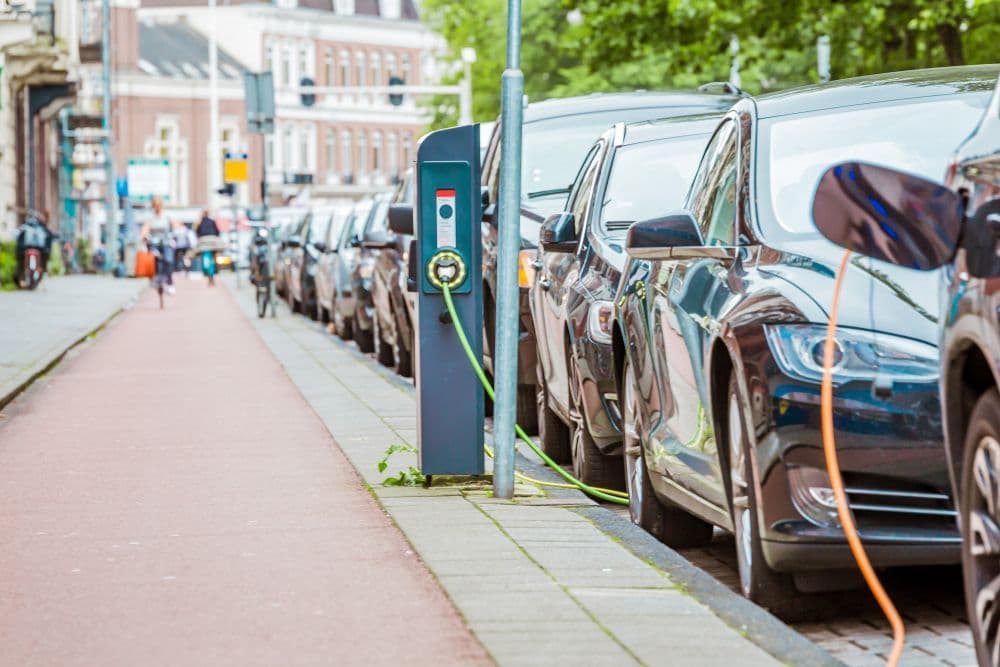If you're looking to get more information about the smart charging in general, we have a PDF guide that uncovers all the crucial technical aspects. It's freely available to download for everyone.
Basic EV charging approach has evolved
Factors such as political, social and environmental, contribute to fast e-mobility growth, hence the charging points communication role changes. In the primarily applied charge ecosystem, the information exchange took place between eMobility Service Providers and Charge Point Operators, and Grid Operators. The relation varies depending on the business model applied. Time (or speed of charging) and location influence the user experience, and economic optimization.
Survey Understanding EV Owners’ Preferences Towards Enrolling in Smart Charging Programs published in June 2020, shows that nearly 70% of respondents demonstrated a high interest in the EV purchase. Additionally, 56% of EV owners consider an EV to be their next vehicle purchase. The growing interest in EV ownership is driven by various incentives and policies. As of 2020, the growth in the share of new electric vehicles in the passenger vehicle market has accelerated remarkably. Especially in Europe, a +137% jump in electric car sales was recorded at the end of 2020.
The growing number of electric vehicles means there is a demand for a well-planned, flexible, and diverse network. At the same time, operators need to scale, provide the service and meet the expectations of EV owners. Following this, the network needs a guaranteed energy supply, especially when there is increased demand. Consequently, the entire system must be well communicated and engineered, to reconcile the peaks of energy demand with limited capacity.
Still, the mentioned ecosystem is not limited and with the growth new players and users will join. For instance, it’s worth mentioning environmental aspects and green energy supplies (and possibly storage). In an effort to meet challenges, the idea of an integrated architecture has been developed, which supports the efficient use of energy flows and optimum market service. All this in a unified communication system.
Why can't this be omitted?
Global EV Outlook predicts that in 2030 in Europe, in the Stated Policies Scenario, the energy demand for EV fleets will grow by 4% (110 TWh). However, the Sustainable Policies Scenario predicts an increased energy demand for electric fleets - up to 6% (187TWh). High peaks are expected at evenings and nights, but in general, global energy demand will rise. To streamline the communication of key domains in the ecosystem (energy supplies, established and expanding charging network and e-mobility services), the information flow should run via an open protocol.
Smart charging comes as a help
Higher energy demand at certain times means not only intensified production but also agile energy distribution. In a nutshell, Smart Charging enables intelligent management of the energy and how the electric vehicle is charged when connected to the grid.
Although higher demand for electricity is not expected to happen before 2030 (according to European Environment Agency’s predictions), still locally grids might be overloaded on high peaks. With efficient use of EVs and charging infrastructure, smart charging comes to help to provide greater network stability without unnecessary expenses.
EU directive 2012/27/EU on energy efficiency describes smart metering systems. The inclusion of smart charging sets top-down endorsement for the development of data exchange systems and in the future standardized and open communication. The use of smart charging implies connecting an EV to a charging device through a data connection, and the charging device to a charging operator through another data connection.
What is Smart Charging?
Smart Charging applies to ‘intelligent’ communication between the charging system, grid and a charged object (here particularly we have in mind an EV, but also this could apply to any chargeable item). Taking an EV as an example, the term ‘smart charging’ means the charging device is ‘communicating’ with the car, the charging operator and the service company links through data. Each time an EV is plugged in, the charger exchanges information to optimize charging.
So, via smart charging the charging service providers (this applies to smart home charging and charging network owners) can guide how much energy and at what cost and time to deliver to any plugged-in EV. Enhanced communication among market participants helps efficiently manage high peaks and energy demand. This helps properly manage time, money and energy.
In practice?
Charging points with smart charging connect EV owners, roaming hubs, and operators. Each time an EV is plugged in, the charging point transfers information (e.g. charging time, speed) to a centralized administration system. Extra data may also be forwarded, e.g. information about the local grid’s potential and how energy is at the moment used at the charging section (house, office building, supermarket etc.). With smart charging management, grids can be in advance informed when the peaks are expected. How? Smart charging also enables scheduling the EV charging. On the one hand, the system is accurately informed as to what amount of energy will be needed at a specific time, on the other hand, the user can plug in the plug and the charging process itself can be programmed at a convenient time interval. This eliminates excess energy use, and the actual power consumption can be conducted at lower tariffs, hence the efficiency.
The stream of data is analyzed and visualized in real-time by the tailored software backing the administration platform. This enables operators to control and manage energy consumption and distribution. Here's a little trivia: some countries already legally mandate the use of smart charging to prevent excessive billing and to utilize electricity productively.
From Charge Point Operator to Smart Charge Point Operator
In the basic model, the charging session starts as soon as the EV is connected to the charging point and stops when the battery is fully charged. In the enhanced scenario, the Charging Service Provider turns into Smart Charging Service Provider. Thanks to a properly designed communication system, SCSP can receive information from the grid when there is a peak in energy production. The same applies to higher energy demands (e.g. nighttime home charging). The third segment is the EV drivers. The information flow delivers the set time when the EV is needed again. Depending on the time frame - If charging applies to the overnight schedule, the EV can be charged much more steadily. For the grid, this indicates more constant, lower power consumption if demand is huge, and higher power consumption if there is a production peak. This extra section, responsible for smart charging communication, ensures that power consumption control is high-performance and effective.
How to implement Smart Charging?
EV charging infrastructure is formed by eMobility Service Providers, Charge Point Operators and roaming hubs. The data exchange aims to provide EV drivers a trouble-free charging experience. Overall information is related to EV electricity consumption. The easiest and most practical way to implement smart charging seems to be open standard implementation. Open protocols aim to ease and scale e-mobility services and accelerate the EV charging market development. Recent versions of OCPI (2.2) and OCPP (2.0.1) support smart charging communication. Privately held OICP and eMIP protocols in charge point information exchange modules also include smart charging operations. In the near future, it might become mandatory to implement Smart Charging modules. Hence Charging Service Providers will become Smart Charging Service Providers connecting the local grid operators and, via the national grid operator, being able to communicate with the energy market.
What is the potential of charging stations?
Smart charging goes beyond just agile energy management. Some pilot programs already exist in which the car not only consumes energy but also delivers it back to the grid (Vehicle-to-grid, V2G). In this way, EVs can actually soak up peaks and troughs occurring on the grid instead of enhancing them. Power back to the grid forms an extra role for Smart Charging Service Provider (within the protocol) that is also valuable for the energy flow within the grid.
Intelligent building architecture takes into account the flow of energy consumption data. In both households and smart office buildings, Smart Charging Service Provider communication will help to utilize energy usage and match it accordingly. For the Charge Point Operators, this also provides additional information about energy use, which will help to ensure sustainable energy consumption. Charging stations with a smart layer can turn into a critical part of a new energy flow network, balancing the load, and providing crucial information to the whole system.
Such a grid-friendly smart module already exists on the German and Swiss markets. The Mobility House provides a grid-friendly feature of the charging processes to ensure a stable electricity supply during a huge energy transition (“Energiewende”). Smart energy management reduces electricity costs, and as the TMH states, it’s due to lower grid fees. In numbers, the savings reach from 60 to 120 euros per year and per charging point, from reduced grid usage fees. Besides, Swiss users show growing demand for controlled charging processes.
The future of charging stations
Notifications, when charging can be done at a lower rate using renewable energy, are encouraging. By forming a benefit system providers can gather a greater audience. The efficient use of charging stations with smart charging is not limited. The e-mobility market is constantly evolving towards optimal use of time and resources. Efficient energy flow means reducing power spikes and pits, even up to 50%. Additionally, enhanced communication between stations and the network, as well as between partners, enables better grid management and the entire efficiency of the e-mobility system.

